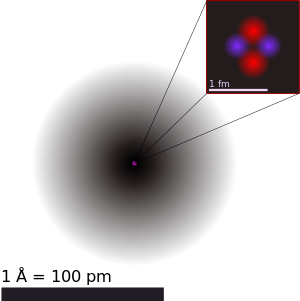Nucleus
Robert Deaton Spring 2022
Definition

A nucleus is a very dense, positively charged region in the center of an atom containing almost all of the atom's mass. Nuclei are comprised of protons, particles of positive charge, and neutrons, particles with roughly the same mass as a proton but with neutral charge. Protons, being positively charged, would be expected to all fly out of the nucleus due to electrostatic repulsion, but they (and neutrons) are tightly bound together by a separate force called the strong nuclear force. So named because it is strong(er than electromagnetism) and nuclear (in the nucleus of an atom). While it may be helpful to think of a nucleus as a ball made of smaller balls as in the picture on the right, in actuality, nuclei are a Schrödinger's mess of a wavefunction. A more realistic depiction would show them as all overlapping in a small probability density cloud of their own, most likely all at the very center. Just as with the electron shell, the nucleus of a helium atom is a spherically symmetric distribution.
Discovery of the Nucleus

If we hearken back to the days of the turn of the 20th century (a truly revolutionary time in physics history), we have to consider the plum-pudding model of an atom put forth by J. J. Thompson just a few years ago in 1904. Thomson had discovered the electron in 1897, and to account for the neutral charge of regular matter and the negative charge of electrons, he proposed that atoms were made of some positively charged *stuff* (pudding) with negatively charged electrons embedded inside (plums). Over the next several years, many experiments headed by Ernest Rutherford and Hans Geiger showed that alpha particles emitted by radioactive elements move more slowly through solid matter than through air (testing with aluminium foil and gold leaf).
So something crazy wild happened in 1909 when Rutherford began paying attention to the trajectories followed by the alpha particles when shot at gold leaf. According to the plum pudding model, the positively charged stuff of the atom should have a negligible effect on the alpha particles because it is evenly distributed. Likewise, the electrons shouldn't affect the trajectory of the particles because their mass is so much smaller; they would just be flung away. So it came as a surprise to Rutherford (and physicists everywhere!) when a substantial number of alpha particles were deflected by significant amounts (several degrees even), and many went in all sorts of directions, including backwards! See the image for a better description.
Rutherford's experiment showed that the center of an atom contained all of an atom's positive charge and mass, and within a couple years, physicists had updated their conceptual model of atoms to account for this. Rutherford had proven that hydrogen nuclei were present in other nuclei and, with the discovery of isotopes (due to physics' newfound fascination with radioactivity), a new atomic hypothesis was formed: the nuclear electrons hypothesis. Since atomic masses are roughly in multiples of the hydrogen nuclei, and hydrogen nuclei were present in other nuclei, it was proposed that protons (hydrogen nuclei) make up the mass of nuclei and electrons are "embedded" in it to balance the charge. For example, in nitrogen-14, there would be 14 protons and 7 electrons in the nucleus to make a net charge of +7. However, there were several issues with the embedded electrons hypothesis. For one, it would cause additional spectral line splitting (at a very fine level) that was not actually observed, and it would cause some nuclei to have a net spin inconsistent with measured values.
Then, in 1930, a new type of radiation was observed when an alpha particle collided with the nucleus of a lightweight atom. This new kind of particle emitted had to be neutral, but it was most certainly not a photon, or else it would have a ridiculous amount of energy. Several experiments were conducted in 1932, mostly due to James Chadwick, that proved that this radiation could not be gamma rays, and furthermore, that this particle had roughly the mass of a proton. Some of these experimental setups were crazy: A polonium alpha-particle source poured radiation onto a lithium metal foil, which would then emit the unknown radiation, which would then collide with molecules of some gas. But this new particle must be present in nuclei! This was it! Nuclear physics came into its own, with neutrons being used to show all kinds of things that previously puzzled physicists including the spin differences of isotopes, beta radiation, and of course, neutron emission (the induced radiation caused by hitting a light nucleus with an alpha particle).
Of course, physicists were keen to make hypothesis after hypothesis (Heisenberg suggested that neutrons were actually composite proton-electron combinations) and experiment after experiment (shooting various types of radiation at things and measuring whatever products were emitted). Nuclear physics really took off.
Putting Numbers on It
The following chart has some properties of protons and neutrons (for properties of actual nuclei of elements, refer to their Wikipedia page or a list-of-isotopes Wikipedia page! There are too many elements to list here!)
| Header C1 | Header C2 | Header C3 |
|---|---|---|
| R1C1 | R1C2 | R1C3 |
| R2C1 | R2C2 | R2C3 |